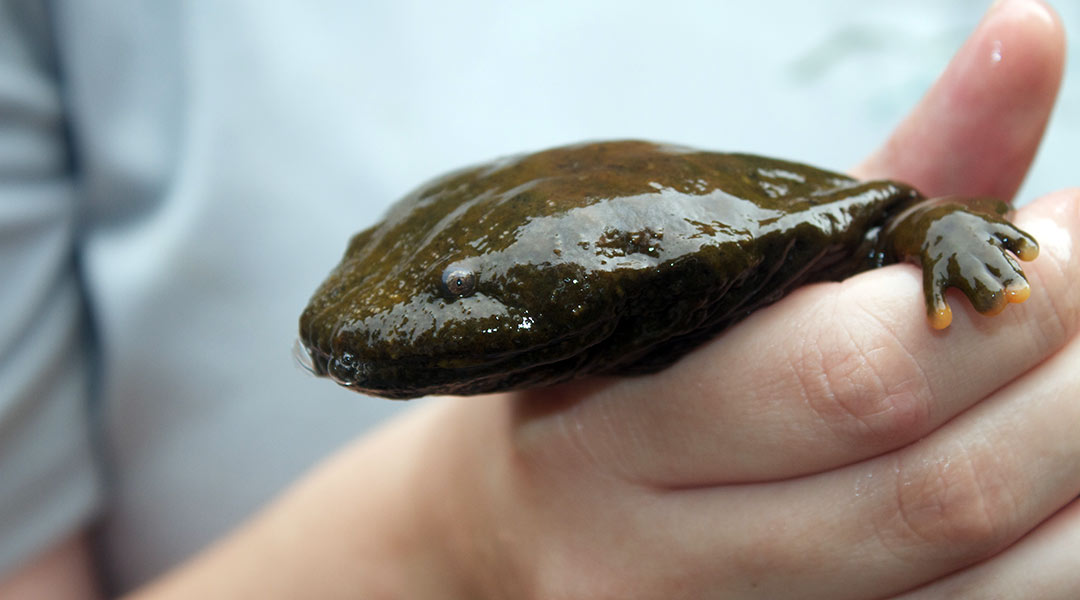Hellbenders are fully aquatic and can live up to 30 years in the wild. (Photos courtesy of Brian Gratwicke on Flickr)
In the pantheon of vulnerable species in North America, the spotlight rarely shines on the eastern hellbender, a giant salamander.
But three undergraduate students at the University of South Carolina have made it the star of their senior research project.
The salamanders are the largest amphibians in North America. They typically grow more than a foot long. The researchers say their size made them stand out as they reviewed different case studies in class.
“They’re easy to remember because they’re massive,” said Hannah Meredith, one of the trio of researchers and a senior environmental science major. “So, it’s kind of crazy to think that we have those in the Carolinas.”
These unique creatures have been declining across their range in the waterways of the Appalachian Mountains.
A major cause of their decline is increased development near their habitats. Less forest cover, poor water quality and erosion can devastate their numbers.
Monitoring this decline and attempting to reverse it is an important subject for research because hellbenders are an indicator species. Like most amphibians, the hellbender is more sensitive to water quality. And their gargantuan size makes them more vulnerable to predators when streams lose forest cover.
When a stream has a stable population of these so-called “devil dogs,” it is a sign that the stream likely can sustain several other species. Where they dwindle, the stream is likely to need some restoration efforts.
The students’ research presents a plan to quantify, monitor and restore a population of hellbenders in West Virginia.
Their long-term solutions include planting more forest cover to protect streams against erosion and chemical pollutants.
That would improve water quality for the entire ecosystem while also providing more cover for the species to live and breed.
The project makes up a total of 60% of their total grade in their environmental issues seminar. While not entirely a passion project, the researchers say they’ve grown passionate about the issue and are excited to present their research at the student-driven Discover USC next month.
“I feel (Discover USC) is a great opportunity to practice presenting research and to learn about the research that my peers have participated in,” said Dani Como, a senior environmental science major and researcher on the project.
Meredith also said the research further inspired her toward a career in conservation.
“I do want to do conservation work eventually so, obviously, it’s so nice to have some experience,” Meredith said. “And it’s just been my favorite assignment that I’ve done this semester.”
She even has volunteered for a project setting up shelters for hellbenders in North Carolina this summer.
The organization she will volunteer with, Conserving Carolina, is hosting a lecture and action series on the hellbender. The group will be further celebrating the species at their Riverfest in June in North Carolina, when attendees will have the opportunity to see a real hellbender.
For South Carolinians, that may be the closest they can get to this somewhat illusive species.
According to an email from Austen Attaway, a biologist with the S.C. Department of Natural Resources, only one sighting of a hellbender was ever recorded in South Carolina. They are native to waterways in North Carolina and Georgia that “barely miss us.”
Small populations of the species can be hard to find, though. S.C. herpetologists could use water DNA samples, if funding were available, to see if there are any stragglers in the Upstate.
Meredith, who is native to the Upstate, hopes more conservation efforts will take place there, too, for any rogue hellbenders and the region as a whole.
“From my experience, I think there’s a lack of conservation efforts in that part of South Carolina,” Meredith said. “I’ve seen a lot in the coastal areas – just dedicating funding and to have conservation organizations that are going to do that kind of thing.”
For those interested in learning more about this one-of-a-kind salamander, Meredith, Como and Lillian Doll will present their research April 21 during Discover USC. People also can travel to Riverfest, on June 17 in Rosman, North Carolina, to see a devil dog in the flesh.
If anyone happens to see a hellbender in the wild in North or South Carolina, they are encouraged to report it to the North Carolina Wildlife Commission by calling (919) 707-0050 or emailing lori.williams@ncwildlife.org.



